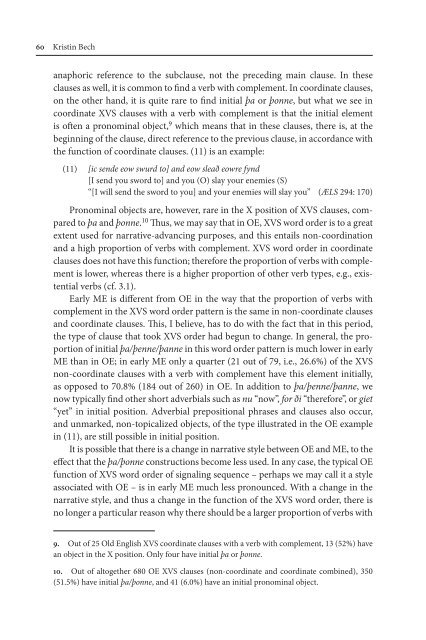Selected Papers from the Fourteenth International ... - STIBA Malang
Selected Papers from the Fourteenth International ... - STIBA Malang
Selected Papers from the Fourteenth International ... - STIBA Malang
Create successful ePaper yourself
Turn your PDF publications into a flip-book with our unique Google optimized e-Paper software.
60 Kristin Bech<br />
anaphoric reference to <strong>the</strong> subclause, not <strong>the</strong> preceding main clause. In <strong>the</strong>se<br />
clauses as well, it is common to find a verb with complement. In coordinate clauses,<br />
on <strong>the</strong> o<strong>the</strong>r hand, it is quite rare to find initial þa or þonne, but what we see in<br />
coordinate XVS clauses with a verb with complement is that <strong>the</strong> initial element<br />
is often a pronominal object, 9 which means that in <strong>the</strong>se clauses, <strong>the</strong>re is, at <strong>the</strong><br />
beginning of <strong>the</strong> clause, direct reference to <strong>the</strong> previous clause, in accordance with<br />
<strong>the</strong> function of coordinate clauses. (11) is an example:<br />
(11) [ic sende eow swurd to] and eow sleað eowre fynd<br />
[I send you sword to] and you (O) slay your enemies (S)<br />
“[I will send <strong>the</strong> sword to you] and your enemies will slay you” (ÆLS 294: 170)<br />
Pronominal objects are, however, rare in <strong>the</strong> X position of XVS clauses, compared<br />
to þa and þonne. 10 Thus, we may say that in OE, XVS word order is to a great<br />
extent used for narrative-advancing purposes, and this entails non-coordination<br />
and a high proportion of verbs with complement. XVS word order in coordinate<br />
clauses does not have this function; <strong>the</strong>refore <strong>the</strong> proportion of verbs with complement<br />
is lower, whereas <strong>the</strong>re is a higher proportion of o<strong>the</strong>r verb types, e.g., existential<br />
verbs (cf. 3.1).<br />
Early ME is different <strong>from</strong> OE in <strong>the</strong> way that <strong>the</strong> proportion of verbs with<br />
complement in <strong>the</strong> XVS word order pattern is <strong>the</strong> same in non-coordinate clauses<br />
and coordinate clauses. This, I believe, has to do with <strong>the</strong> fact that in this period,<br />
<strong>the</strong> type of clause that took XVS order had begun to change. In general, <strong>the</strong> proportion<br />
of initial þa/þenne/þanne in this word order pattern is much lower in early<br />
ME than in OE; in early ME only a quarter (21 out of 79, i.e., 26.6%) of <strong>the</strong> XVS<br />
non-coordinate clauses with a verb with complement have this element initially,<br />
as opposed to 70.8% (184 out of 260) in OE. In addition to þa/þenne/þanne, we<br />
now typically find o<strong>the</strong>r short adverbials such as nu “now”, for ði “<strong>the</strong>refore”, or giet<br />
“yet” in initial position. Adverbial prepositional phrases and clauses also occur,<br />
and unmarked, non-topicalized objects, of <strong>the</strong> type illustrated in <strong>the</strong> OE example<br />
in (11), are still possible in initial position.<br />
It is possible that <strong>the</strong>re is a change in narrative style between OE and ME, to <strong>the</strong><br />
effect that <strong>the</strong> þa/þonne constructions become less used. In any case, <strong>the</strong> typical OE<br />
function of XVS word order of signaling sequence – perhaps we may call it a style<br />
associated with OE – is in early ME much less pronounced. With a change in <strong>the</strong><br />
narrative style, and thus a change in <strong>the</strong> function of <strong>the</strong> XVS word order, <strong>the</strong>re is<br />
no longer a particular reason why <strong>the</strong>re should be a larger proportion of verbs with<br />
9. Out of 25 Old English XVS coordinate clauses with a verb with complement, 13 (52%) have<br />
an object in <strong>the</strong> X position. Only four have initial þa or þonne.<br />
10. Out of altoge<strong>the</strong>r 680 OE XVS clauses (non-coordinate and coordinate combined), 350<br />
(51.5%) have initial þa/þonne, and 41 (6.0%) have an initial pronominal object.










